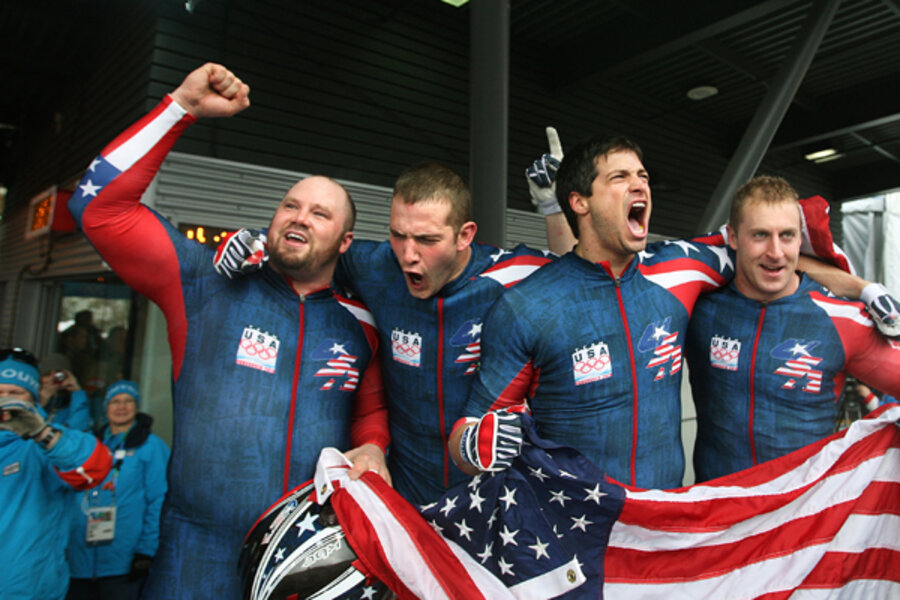Gold rush: Steve Holcomb barrels US bobsled to top of podium
Loading...
| Whistler, British Columbia
Barreling down the Whistler Sliding Track at 95 miles per hour, Steve Holcomb couldn’t see very well.
But that was all part of the plan he’s had since 1994 to win a gold medal.
Holcomb has an uncanny ability to drive largely on feel – something he bolsters by intentionally wearing a scratched visor that limits visual input. Despite having little time to learn the course here that has caused so many bobsleds to careen across the finish line upside down, Holcomb guided his 1,400-lb. “Night Train” sled to four stellar runs on Friday and Saturday, capturing America’s first gold in the sport since 1948.
He also became the first driver to beat Germany in the Olympic event in nearly two decades.
“We had two very strenuous days and we can say that Steven really deserves this gold medal,” said Kevin Kuske, a crewman for Germany’s veteran pilot Andre Lange, who came from behind to win silver by 0.01 seconds. “Especially in the fourth heat, we definitely gave it all.”
Grunts, roars – and history
At the start house before the final teams took their historic runs, Lange stood quietly by his sled while his crew got amped up for the run – grunting, roaring, and jumping in place like exploding lava. Then, a moment of tense calm – eight massive legs poised to spring, shaking like racehorses in the gate.
And they were off!
They rumbled down the fastest track in the world, flying perpendicular to the ground around banked turns with nothing but four slender runners and centrifugal forces gluing them to the ice. After a rough start Friday, Lange found the track’s sweet spots and bumped Canada-1 into bronze in the final seconds of the run, capping an illustrious career that includes four Olympic golds, eight world titles – and now, an Olympic silver medal.
Meanwhile, Holcomb and his crew – the reigning world champions – finished their warmup in a deserted parking lot, alone on top of the course just moments before they would be on top of the world.
Then, after half a dozen volunteers brushed tiny ice shavings off the track for the last time, the Night Train crew stripped down to their red, white, and blue spandex and tried not to think about the 62-year drought in US bobsled gold.
“I didn’t want to be the guy to blow a half-second lead and lose a gold medal,” said Holcomb, who had held an impressive margin in the first three runs. “You can lose a tenth [of a second] in a dozen corners here. You can crash all over the place.”
Coming across the finish line, Holcomb knew he’d made an error but didn’t know how much it’d cost him. The roaring crowd was just a blur as Curt Tomasevicz applied the brake, a mousetrap-like contraption that clamps onto the ice and brings the sled to a skidding stop on the uphill run-out.
“When you hear everybody screaming and yelling, it’s hard to hear if they’re cheering for you or because you got beat by Germany,” said Holcomb, whose other crew members include Steve Mesler and Justin Olsen. “As soon as I saw my team was holding up the No. 1, it was a huge moment.”
How Holcomb got his 'super genius'
Holcomb is almost universally acknowledged as a rare breed when it comes to driving.
“He just has a feel that very few people in the world, if any, have,” said Tomasevicz, Holcomb's longtime brakeman. German crewman Kuske called his skills “super genius.”
So where did Holcomb, a computer whiz and video game aficionado, get it from?
“A lot of it comes from my ski racing background,” said Holcomb, who switched to bobsled in 1998 and became a driver four years later. “You have an ideal line going down the hill, but it’s very rare that you’re actually on that line. You learn to anticipate and correct before the problem has started.”
To learn the Whistler track, Holcomb scrutinized video footage of high-speed turns and watched what other teams were doing. He also got back up from USA Bobsledding.
“We’ve been strategic about learning as much as we can about this track from a technological standpoint,” said Darrin Steele, CEO of the US Bobsled and Skeleton Federation and a two-time Olympian. “We knew [Steve] was capable – but so was Lange, [Canada’s Lyndon] Rush, [Russia’s Alexsandr] Zubkov. There are some unbelievable teams out there.”
Holcomb also credited Lange for helping him improve.
“He’s been a great competitor,” said Holcomb. “He’s definitely pushed my game to a new level.”
Lange, whose win in the two-man bobsled here at the Vancouver Olympics made him the only athlete in the history of his sport to win four Olympic gold medals, took the final run of his career Saturday.
“When I stepped out of the sled today, I had to take a deep breath and tears came to my eyes. It feels like a huge burden has been lifted,” said Lange, who exited the sport with pride – and praise for Holcomb’s crew. “They certainly are great and worthy winners, and we will cherish our silver medal.”
Follow Christa's updates on Twitter, and look for her stories on Facebook.





